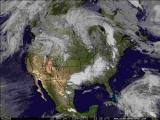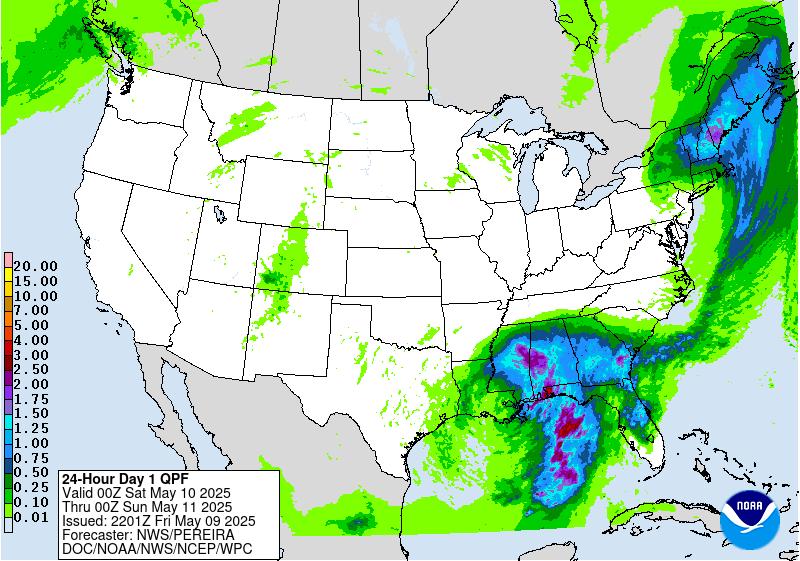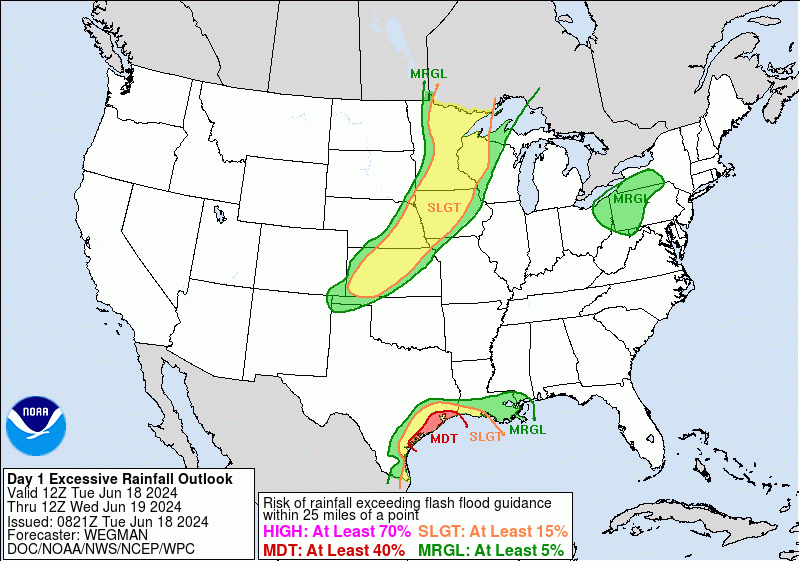Excessive Rainfall Discussion
NWS Weather Prediction Center College Park MD
857 PM EDT Thu May 16 2024
Day 1
Valid 01Z Fri May 17 2024 - 12Z Fri May 17 2024
...THERE IS A HIGH RISK OF EXCESSIVE RAINFALL FOR PORTIONS OF
SOUTHWEST LOUISIANA AND A SMALL PORTION OF ADJOINING SOUTHEAST
TEXAS...
...01Z Update...
On-going flash flooding event will be shifting eastward...with the
focus gradually moving out of southeast Texas into Louisiana. The
area of highest rainfall rates have gradually been pushing
southward towards the Gulf of Mexico while simultaneously a complex
that was moved hrough the Houston area around 00Z and was
approaching the coastline as of 01Z has been the western edge of
the greatest flash flood threat with some upscale growth noted with
clusters north and northwest of Lake Charles. That suggests the
worst flash flooding threat will be shifting south of Interstate 10
and may even be offshore...especially in Texas...within the next 6
to 8 hours...and which should persist longer in Louisiana. Short
term high- resolution guidance has latched on the the system
becoming progressive and with a sharp cutoff to rainfall across all
of Texas by 05Z. Given the convection that continues to percolate
to the on-going complex in an atmosphere that has been thouroghly
worked over suggests the HRRR and ARW may be too quick to end the
QPF. Given the potential for overlap with the footprint of todays 2
to 4 inch rainfall...with embedded higher amounts...opted to keep
the high risk and moderate risk areas although both were shrunk
from earlier in the day. Kept the Slight Risk area extending
westward to cover the potential of active convection reaching areas
made hydrologically more sensitive earlier today. One offsetting
factor may be the increasing forward speed of this convection
although any additional rainfall could easily result in worsening
on-going flooding and lead to additional areas of flooding.
Kept a Marginal Risk extending north/northeastward along the
Mississippi River. Rainfall rates have not been particularly
dramatic during the day...but increasing flow of the particularly
moist airmass could still result in localized excessive rainfall
into the late evening hours.
Bann
...16Z Update...
The premise of the previous forecast remains the same with a
Dangerous and Life-Threatening flash flood event forecast across
portions of east TX through western LA. The recent trends in hi-res
guidance have allowed for a further consensus on where the heaviest
precip will occur, and the magnitude of the potential with the 12z
HREF probability fields very much outlining the upper end prospects
for not only flash flooding, but significantly impactful flooding
given the anticipated totals, rates, and antecedent soil moisture
for the area(s) of impact.
A couple of the probability fields that stand out include; 12z
HREF EAS probability for at least 3" is now upwards of 50-80%
within the confines of east TX from Trinity county to just across
the LA line. Probabilities above 60% for the EAS are statistically
significant due to how that probability is calculated and reserved
for higher end consensus amongst the hi-res deterministic and
time- lagged suite within the ensemble. Neighborhood probability
for at least 2"/hr rates have grown in areal coverage through the
period with a general 20-40% located from central TX down through
the Piney Woods area north of Houston. A bullseye of 50-60% is
located across east TX during the late-afternoon to early evening
hours across the above area as well, signaling the potential for
prolific rainfall within the expected High Risk zone. The last
statistically significant probability is the zone of >50%
probability for at least 5" based on the 12z HREF neighborhood
probability over east TX. 50-70% probabilities encompass the entire
zone within the forecasted High Risk, a positive correlation for
the potential and current forecast.
Precip totals within the latest HREF blended mean are now between
5-8" within the outlined High Risk as well, so the pattern is
favorable and becoming inherently agreed upon by the short term
guidance. This is a high-end flash flood potential for many across
TX through portions of the Lower Mississippi Valley as the complex
is expected to translate eastward into the Deep South by the end of
the period.
A SLGT risk was also added to portions of the Mid-Mississippi
Valley. More on that risk below...
...Mid-Mississippi Valley...
Increasing ascent within the right-entrance region of a
strengthening jet streak will provide sufficient forcing across
portions of northern AR up through southern MO and adjacent bounds
of KY/TN/IL. Surface cold front will lie to the north of the
aforementioned area with a defined warm sector positioned south of
the front. Weak shortwave pulse ejecting out from the southwest
will cross overhead after sunset with a percolating convective
field beginning over AR. As the impulse moves northeast, a steady
initiation of scattered thunderstorms will transpire over the above
region with rainfall rates capable of exceeding 1-2"/hr based on
the latest HREF probabilities for the respective hourly rates
(1"/hr exceedance probability of 50-70% across northern AR into
southeast MO). FFG indices are much lower over the AR/MO border
extending to the northeast due to multiple events that have allowed
for soil priming the past few weeks. With rainfall totals generally
between 1-3" with locally higher among the latest hi-res suite, and
HREF EAS probabilities for at least 1" now upwards of 60-70% with
2" around 20%, the prospects for localized flash flooding have
increased enough to warrant an upgrade to a SLGT risk across the
aforementioned portion of the Mid-Mississippi Valley.
Kleebauer
...Previous Discussion...
...DANGEROUS AND LIFE-THREATENING FLASH FLOODING LIKELY...
In coordination with HGX/Houston, TX; SHV/Shreveport, LA; and
LCH/Lake Charles, LA forecast offices, a High Risk upgrade was
introduced with this update. Dangerous and life threatening flash
flooding is likely in the High Risk area of the Piney Woods.
A vigorous shortwave trough leading a 110 kt zonal jet will move
across Texas today into tonight. Meanwhile, a moisture laden air
mass from the Gulf will advect north into eastern Texas today. The
air mass is characterized by PWATs that may exceed 2.25 inches,
which is above the 95th percentile for PWATs for this time of year,
and is over 3 sigma above normal. In portions of Louisiana this
exceeds the 99th percentile. All this to say, there will be plenty
of moisture for storms to work with as they move east. Instability
advecting northward with the moisture from the Gulf will approach
4,000 J/kg south of the line, but that level of instability will
further support very deep convection. The result is the expected
storms will be capable of extreme rainfall rates that may exceed 3
inches per hour with the strongest storms, but even with much of
the convection, 1-2 inch per hour rainfall rates will be common.
An impressive theta-e gradient over south-central Texas will push
northward on the low-level jet this morning. Some convection has
already fired across the Moderate and High Risk areas already this
morning, but it will take the arrival of the deep Gulf moisture
characterized by surface dewpoints will into the 70s to get the
storms going with daytime heating late this morning. An MCS is
likely to develop across north Texas late this morning with
embedded storms producing extreme rainfall rates. The line will
push southeastward rather quickly, but more convection developing
out ahead of the line, as well as training segments will make for a
rather small-width, but extended length line of convection that
could produce rainfall totals of 3-5 inches with local amounts as
high as 8 inches.
As the storms move into the High Risk area, a push of even deeper
moisture will greet the storms and allow them to further intensify
as they push east across the area. There has been better than
normal agreement in the overall guidance suite for multiple inches
of rain to occur as the storms move through, highlighting the Piney
Woods region for multiple days. With the full CAMs suite now
actualizing the event in the same place, confidence has increased
for the issuance of the High Risk.
AHPS data shows that the High Risk area has seen over 600% of their
normal rainfall for the past 2 weeks alone. Moderate to Major river
flooding is already ongoing in this area. Soils are not expected
to retain any of the rainfall expected today. Rates of 2 inches
per hour with locally higher rates will very quickly re-raise
levels in smaller creeks and streams, while the major rivers
already in flood stage will also see rises. Widespread flash
flooding with locally significant and life-threatening flash
flooding is likely as a result.
A couple cons still adding a bit of uncertainty to the forecast:
1) The cells will be fast-moving so any one area may only see the
extreme rainfall rates for a fraction of an hour, but training of
multiple storms capable of the high rates is expected over the High
Risk area. 2) Rain will only fall for 3-6 hours over the high risk
area as the strong storms move through. Thus, the 3-5 inches of
rain expected will fall over that much shorter time period. This
certainly raises the chances for flash flooding, but with no rain
expected following the storms, this does limit the severity of the
flooding expected somewhat.
As the storms push east across Louisiana tonight, they will weaken
a bit due to the loss of daytime heating and associated
instability, so amounts will drop off as the storms approach
Mississippi. This area has been hard hit with recent rains and
nearly saturated soils, but not as hard-hit as portions of Texas.
Thus, with decreasing rates, the risk areas trail off to the east.
However, there is considerable uncertainty as to how fast that will
happen and certainly where the storms will train towards the east
across Louisiana. Thus, the eastern boundaries of the Moderate and
Slight risk areas are more uncertain.
...North Central Texas...
Better agreement in the CAMs for an axis of heavy rain developing
along the aforementioned theta-e gradient this morning will allow
convection capable of very heavy rains to develop in the vicinity
of the Dallas-Fort Worth Metroplex. Most of the guidance suggests
the strongest convection will be on the west/Fort Worth side of the
Metroplex, so the threat is a little bit lower for Dallas. Nonetheless,
low FFGs characteristic of large cities will allow flash flooding
to develop much more quickly and with less rain than surrounding
areas. In coordination with FWD/Fort Worth, TX forecast office, a
Moderate Risk upgrade was introduced with this update. The
strongest storms will quickly shift south of the Metroplex this
afternoon, but lingering light to moderate rain may continue into
the evening, lengthening the duration of any flash flooding.
Wegman
|






















































































